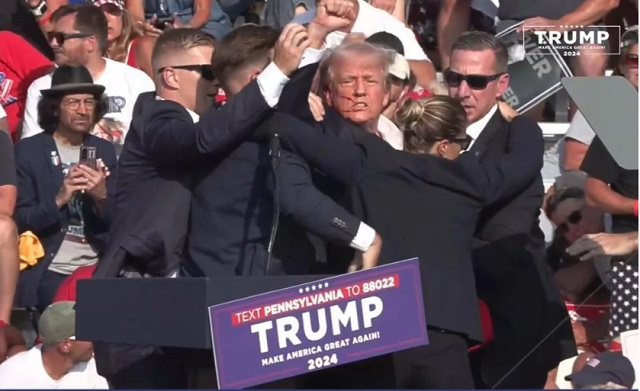International
Oversight committee investigates alleged Google censorship of Trump shooting

From The Center Square
By Casey Harper
U.S. House Oversight Chair Rep. James Comer, R-Ky., launched an investigation Wednesday into allegations that Google and Meta, formerly known as Facebook, censored or misrepresented content about President Donald Trump and Vice President Kamala Harris.
Comer sent letters to Meta CEO Mark Zuckerberg and Google CEO Sundar Pichai Wednesday over the alleged censorship, which grabbed national attention after the near-fatal assassination attempt against Trump in Butler County, Pennsylvania July 13.
How Google and Facebook handled questions and searches about the assassination attempt against Trump sparked criticism.
“Specifically, Meta’s AI assistant claimed, ‘the attempted assassination of former President Donald Trump was a ‘fictional’ event,’ even as the chatbot ‘had plenty to say about Democratic rival Kamala Harris’ run for the White House,” Comer wrote, citing a New York Post article. “When asked if the assassination on President Trump was fictional, Meta’s bot responded that there ‘was no real assassination attempt on Donald Trump. I strive to provide accurate and reliable information, but sometimes mistakes can occur.’ The bot further added, ‘[t]o confirm, there has been no credible report or evidence of a successful or attempted assassination of Donald Trump.’”
Facebook’s team also admitted that it censored the photo of a bloody Trump holding his fist in the air just after the shooting, a photo that went viral online and became a rallying point for his campaign.
“This was an error,” Facebook Communications Director Dani Levi wrote on X about the photo. “This fact check was initially applied to a doctored photo showing the secret service agents smiling, and in some cases our systems incorrectly applied that fact check to the real photo. This has been fixed and we apologize for the mistake.”
“Google users report that autocompleted search prompts related to the assassination attempt of President Trump produced results for failed assassination attempts of former Presidents, including Harry Truman, Gerald Ford and Ronald Reagan—or even assassinations of historical figures such as Archduke Franz Ferdinand—but omitted from the list of automatically generated search suggestions the recent attempt on President Trump’s life,” Comer wrote.
Google told CBS MoneyWatch that the search issues were technical “anomalies” that were unintentional and could affect anyone.
Comer’s investigation is calling for documents and answers on how Google’s search and autocomplete works. Google staff briefed the committee earlier this month.
“In response to preliminary staff inquiries, Google contends that the Autocomplete results omitted the Trump assassination attempt due to a safety protocol concerning predicted assassination attempts of current political leaders, and Google had not yet updated the Autocomplete feature to reflect that an assassination attempt of President Trump had occurred,” Comer wrote.
In his letter to Mark Zuckerberg, CEO of Meta, formerly known as Facebook, Comer pointed out that the executive branch regulates the tech companies that can have bias in determining who runs the executive branch.
“The Committee has long been concerned with how large technology companies leverage their businesses to influence public opinion—especially the design and use of content moderation policies within private sector social media companies—and how company policies are shaped and influenced by Executive Branch officials,” Comer wrote in his letter to Zuckerberg.
After the issues last month, Trump blasted both companies online, saying “here we go again” and calling it “rigging the election,” an apparent reference to how social media companies at the urging of the FBI censored news stories about the Hunter Biden laptop as Russian disinformation but the laptop later was found to be real.
Casey Harper
D.C. Bureau Reporter
Crime
UK finally admits clear evidence linking Pakistanis and child grooming gangs

Quick Hit:
After years of denial and political cover-ups, the UK government has formally acknowledged a disturbing link between Pakistani-heritage men and child grooming gangs. A scathing new review has prompted Prime Minister Keir Starmer to reverse course and launch a full national inquiry into the widespread abuse.
Key Details:
- The Casey Review found “clear evidence” of Pakistani men’s overrepresentation in grooming gangs and accused authorities of ignoring the abuse to avoid accusations of racism.
- Home Secretary Yvette Cooper confirmed over 800 historic child sex abuse cases will be reopened and prosecuted where possible.
- The Labour Party and Prime Minister Starmer were previously opposed to a national inquiry, with critics calling this reversal a politically motivated “smokescreen.”
Diving Deeper:
The British government has finally acknowledged a link between Pakistani-heritage men and the grooming gang epidemic that has plagued communities across England for decades. The admission comes following the release of a damning public review led by Baroness Louise Casey, which uncovered years of institutional failure, racial sensitivity, and political cowardice.
Home Secretary Yvette Cooper presented the findings in Parliament, confirming that the Casey Review had “identified clear evidence of over-representation among suspects of Asian and Pakistani-heritage men.” She condemned the systematic rape of vulnerable girls—some as young as 10—and the authorities’ “unforgivable” failure to act.
“The sexual exploitation of children by grooming gangs is one of the most horrific crimes,” Cooper said, noting that too many warnings had been ignored over the last 15 years. She announced that the government would adopt all of Baroness Casey’s recommendations and reopen more than 800 historic cases.
Prime Minister Keir Starmer, who previously dismissed calls for a national inquiry as “far-right misinformation,” abruptly changed course over the weekend and agreed to a full inquiry with legal authority to compel testimony. This reversal followed mounting pressure from campaigners like Dame Jasvinder Sanghera, Elon Musk, and Reform UK’s Nigel Farage.
Labour MP Sarah Champion, once ousted for raising alarms about Pakistani grooming gangs in her Rotherham constituency, welcomed the inquiry. “There’s a real sense justice has not been handed out fairly,” she said, accusing officials of failing victims for fear of “causing offense.”
The Casey review also pointed to illegal immigration as a contributing factor and called for mandatory ethnicity data collection in child exploitation cases. Critics argue that authorities in Labour-run areas turned a blind eye to the abuse—some allegedly in exchange for votes—treating white working-class girls as expendable while shielding perpetrators.
Former detective and grooming whistleblower Maggie Oliver expressed skepticism, warning that unless the inquiry is led by Baroness Casey, it risks becoming another whitewash. “This is about gross criminal neglect at the top of policing, at the top of government, at the top of social services,” Oliver said.
While the inquiry marks a long-overdue step toward accountability, some warn it may be politically perilous for Starmer. As former head of the Crown Prosecution Service, he held a central role when many of these abuses first surfaced. And with many of the cover-ups tied to Labour councils, the fallout could deepen public distrust in the party.
Business
Trump family announces Trump Mobile: Made in America, for America

 MxM News
MxM News
Quick Hit:
On the 10-year anniversary of Donald Trump’s iconic campaign launch, the Trump family announced the debut of Trump Mobile, a new wireless company offering American-built smartphones, 5G coverage, and a values-driven alternative to Big Tech carriers.
Key Details:
-
Donald Trump Jr. and Eric Trump introduced Trump Mobile’s flagship service Monday, calling it a “transformational” alternative aimed at “our nation’s hardest-working people.”
-
The “47 Plan,” priced at $47.45/month, offers unlimited talk, text, and data, free international calls to U.S. military families, telehealth, roadside assistance, and no credit checks.
-
Trump Mobile’s customer support is fully U.S.-based and live 24/7—“not automated,” the company says—while a new American-made “T1 Phone” is slated for release in August.
Diving Deeper:
Marking ten years since President Donald Trump descended the golden escalator to launch his first campaign, the Trump Organization on Monday announced its boldest private sector move yet: Trump Mobile.
Flanked by company executives, Donald Trump Jr. and Eric Trump unveiled the new cellular service, touting it as a patriotic, people-first alternative to legacy providers. “We’re building on the movement to put America first,” Trump Jr. said in a statement. “We will deliver the highest levels of quality and service.”
The cornerstone of Trump Mobile is the 47 Plan. Offered for $47.45/month, the plan includes unlimited data, full 5G coverage across all three major carriers, and a suite of benefits tailored to middle-class families, truckers, veterans, and anyone tired of paying premiums to companies that don’t share their values.
Among the key perks: 24/7 American-based customer service (with “real people,” not bots), comprehensive device protection, roadside assistance through Drive America, and telehealth services including mental health support and prescription delivery. Most notably, the plan includes free international calling to over 100 countries—an effort the Trump family says honors U.S. military families stationed abroad.
“We’re especially proud to offer free long-distance calling to our military members and their families,” said Eric Trump. “Those serving overseas should always be able to stay connected to the people they love back home.”
Unlike traditional providers, Trump Mobile advertises no contracts and no credit checks, appealing to a demographic long underserved by mainstream telecom giants. “Hard-working Americans deserve a wireless service that’s affordable, reflects their values, and delivers reliable quality they can count on,” Eric Trump added.
The company is also preparing to launch the T1 Phone in August—a sleek, gold smartphone “engineered for performance” and “proudly designed and built in the United States.” With that, the Trump Organization is not just entering the mobile market—it’s staking a claim as a direct competitor to Apple and Samsung.
-

 Business2 days ago
Business2 days agoEU investigates major pornographic site over failure to protect children
-

 Canadian Energy Centre2 days ago
Canadian Energy Centre2 days agoCross-Canada economic benefits of the proposed Northern Gateway Pipeline project
-

 Economy2 days ago
Economy2 days agoCarney’s Promise of Expediting Resource Projects Feels Like a Modern Version of the Wicked Stepmother from Disney’s Cinderella
-

 Alberta2 days ago
Alberta2 days agoAlbertans need clarity on prime minister’s incoherent energy policy
-

 conflict17 hours ago
conflict17 hours ago“Evacuate”: Netanyahu Warns Tehran as Israel Expands Strikes on Iran’s Military Command
-

 Energy17 hours ago
Energy17 hours agoCould the G7 Summit in Alberta be a historic moment for Canadian energy?
-

 Health21 hours ago
Health21 hours agoLast day and last chance to win this dream home! Support the 2025 Red Deer Hospital Lottery before midnight!
-

 Crime2 days ago
Crime2 days agoManhunt on for suspect in shooting deaths of Minnesota House speaker, husband






